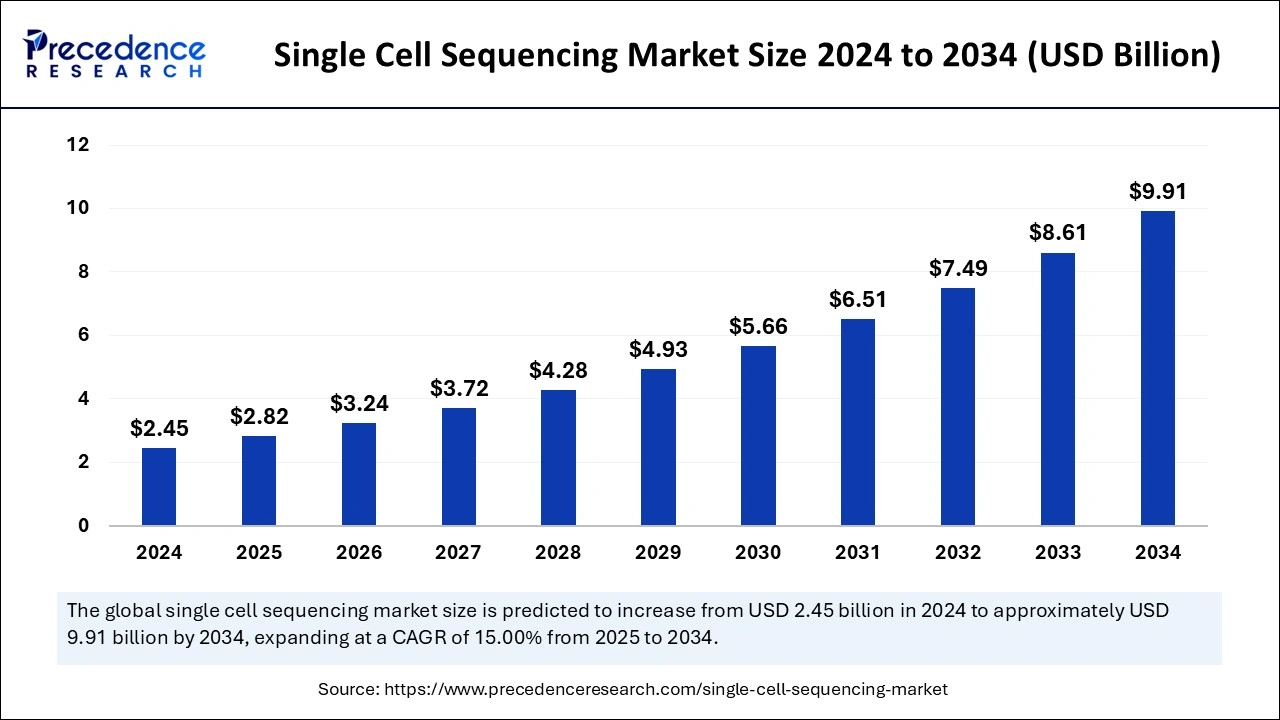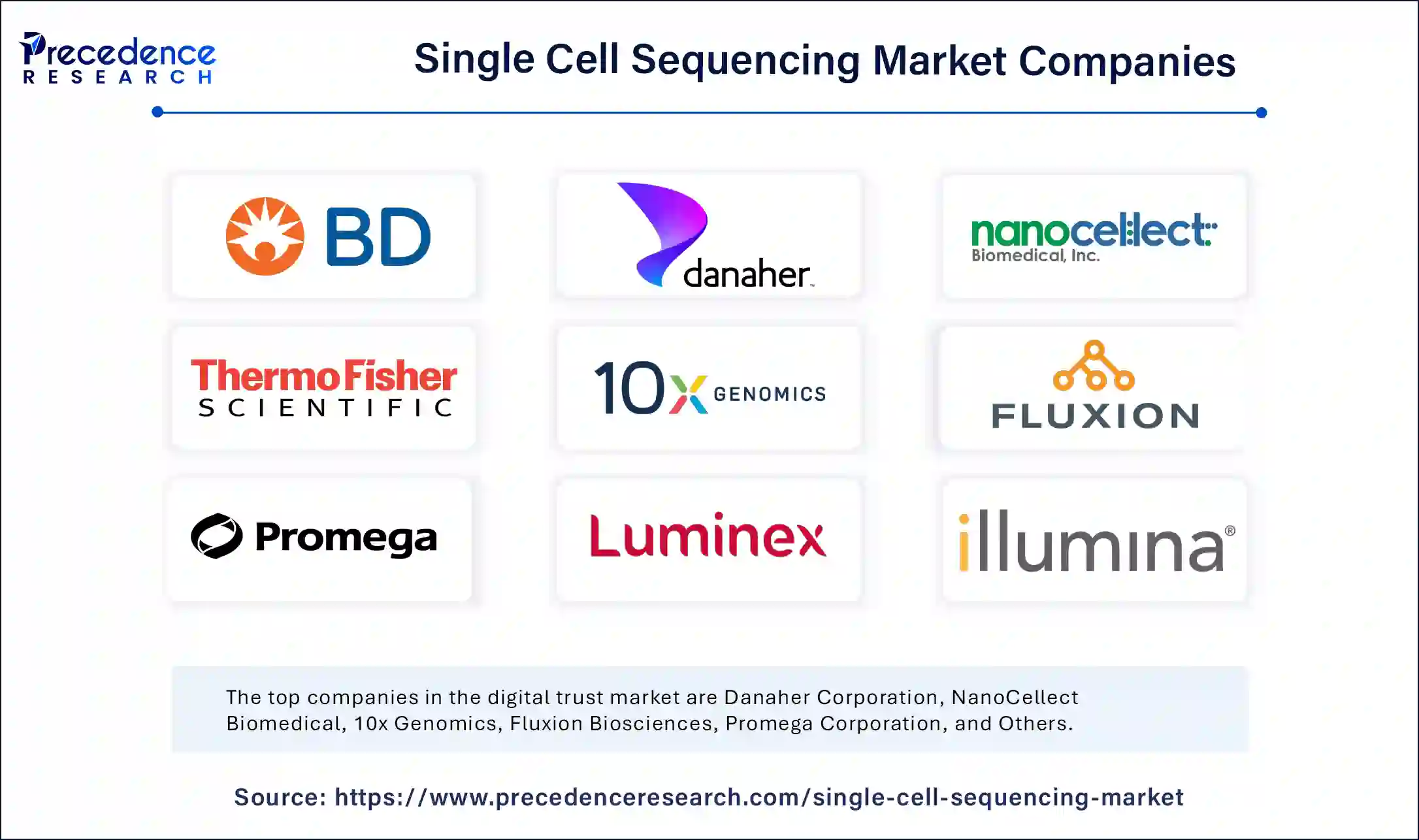January 2025
The global single cell sequencing market size is calculated at USD 2.82 billion in 2025 and is forecasted to reach around USD 9.91 billion by 2034, accelerating at a CAGR of 15.00% from 2025 to 2034. The market sizing and forecasts are revenue-based (USD Million/Billion), with 2024 as the base year.
The global single cell sequencing market size accounted for USD 2.45 billion in 2024 and is expected to exceed around USD 9.91 billion by 2034, growing at a CAGR of 15.00% from 2025 to 2034. Technological advances in the field of genomics are the key factor driving market growth. Also, the increasing incidence of genetic diseases coupled with the collaboration among academic institutions can fuel market growth soon.

Artificial Intelligence is extensively used in the single cell sequencing market, especially for the classification and identification of pathogens. AI technology can rapidly process NGS data and detect pathogens in samples in no time, which is important for the quick diagnosis of various diseases. Furthermore, AI algorithms can precisely classify pathogens based on the genomic data available, which is essential for controlling their progress and transmission.
The single cell sequencing market covers the applications of transcriptomic and genomic techniques to analyze isolated single cells. The access to advanced sequencing platforms like long-read technologies, enabled scientists and researchers to create robust and inexpensive sequence data. This technique enabled the identification and characterization of the cells and offered detailed insights into all types of cells.
| Report Coverage | Details |
| Market Size by 2024 | USD 2.45 Billion |
| Market Size in 2025 | USD 2.82 Billion |
| Market Size in 2034 | USD 9.91 Billion |
| Market Growth Rate from 2025 to 2034 | CAGR of 15.00% |
| Dominating Region | North America |
| Fastest Growing Region | Asia Pacific |
| Base Year | 2024 |
| Forecast Period | 2025 to 2034 |
| Segments Covered | Product, Technology, Application, and Regions. |
| Regions Covered | North America, Europe, Asia-Pacific, Latin America, and Middle East & Africa. |
Increasing application in precision medicine
The single cell sequencing market in precision medicine offers data on the genetic basis of disorder at the level of an individual cell. It also helps in developing individualized treatment plans, forecasting the risk associated with any disease, and detecting new therapeutic targets. In addition, it offers important data on the development and performance of immune cells in the field of immunology, thus optimizing the innovations in new immunotherapies.
Uncertain reimbursement policies
The major factors impeding the market growth are the limited reimbursement policies and high investment requirements. The limited availability of bioinformatics solutions, along with the high cost associated with the single-cell genome sequencing process, can constrain the single cell sequencing market. Moreover, the increasing geriatric population and growing incidence of chronic conditions can hamper market growth shortly.
Innovations in sequencing technologies
The ongoing innovations in sequencing technologies have substantially impacted the growth of the single cell sequencing market. The launch of next-generation sequencing (NGS) platforms has allowed scientists to sequence big volumes of RNA and DNA at a rapid pace with less cost. Furthermore, the introduction of cutting-edge single-cell sequencing technologies like droplet-based microfluidics platforms has improved the abilities of single-cell genome sequencing.
The consumable segment dominated the single cell sequencing market in 2024. The dominance of the segment can be attributed to the increasing preference by researchers for consumables in the single-cell analysis process and the growing need for associated consumables. Additionally, this segment is important for DNA/RNA sequencing, supporting DNA-based diagnostics and research, which is fuelled by the growing demand for cancer treatment and personalized medicine.
The instruments segment is expected to grow at the fastest rate over the forecast period. The growth of the segment can be credited to the fast evolution and acceptance of innovative instruments specially manufactured to align with the changing landscape of the healthcare sector. Also, the single-cell sequencing solution is created for analysis of gene expression in single cells, enabling researchers to know their functions.
The PCR segment led the global single cell sequencing market in 2024. The dominance of the segment can be linked to the increasing collaborations among the different research institutes coupled with the initiatives taken by key market players. Moreover, It is a very critical technique that enables the fast amplification of a particular segment of DNA. PCR creates billions of copies of a special DNA segment.
The th0065 sequencing segment is expected to grow at the fastest rate during the projected period. The growth of the segment can be driven by ongoing developments in sequencing technologies. This is a statistical technique for detecting putative functional elements in various genomes, such as SNP frequency and GC content. In addition, the major advantage of sequencing is it provides a comprehensive analysis of a person's entire genome.
In 2024, the oncology segment dominated the single cell sequencing market by holding the largest share. The dominance of the segment is due to the increasing prevalence of colorectal, prostate, and breast cancers. Furthermore, the segment is growing because of increasing innovations in cancer research, like immunotherapy, precision medicine, and genetic testing. The surge in several R&D activities can soon influence market growth positively.
The immunology segment is anticipated to grow at the fastest rate over the forecast period. The growth of the segment can be linked to the developments in single-cell sequencing technologies, including enhanced bioinformatics tools and droplet-based methods, which have made it convenient to process large amounts of individual cells swiftly. The increasing prevalence of autoimmune diseases like multiple sclerosis and rheumatoid arthritis can lead to market expansion further.
North America dominated the global single cell sequencing market in 2024. The dominance of the segment can be attributed to the increasing prevalence of cancer and chronic diseases and innovative product launches. Also, growing collaboration among key companies, along with the surging biotechnology and pharmaceutical industries, can fuel market growth further. Moreover, in North America, the US led the market owing to the numerous government initiatives and strong research and development facilities.
Asia Pacific is expected to grow at the fastest rate in the single cell sequencing market over the studied period. The growth of the region can be credited to the growing geriatric population which is contributing to the growing incidence of chronic diseases. Furthermore, the significant growth in healthcare infrastructure, facilitated by the economic development in emerging economies like India and Indonesia, can soon boost market growth in the region.

By Product
By Technology
By Application
By Geography
For inquiries regarding discounts, bulk purchases, or customization requests, please contact us at sales@precedenceresearch.com
No cookie-cutter, only authentic analysis – take the 1st step to become a Precedence Research client
January 2025
January 2025
February 2025
January 2025